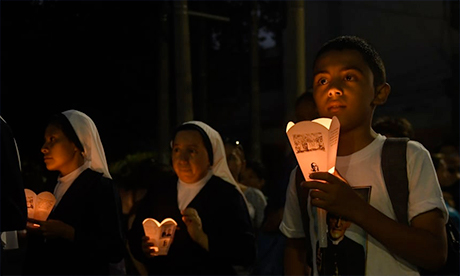It has become one of the most commonplace and influential ideas about religion: that it is the cause of much, if not most, of the conflict and violence in the world.
While this is not a new idea — religious passions have long been deemed suspect for their potential to causes divisions — the notion that religion is intrinsically violence-inducing has become much more deeply ingrained in recent times.
This image of religion as a primary propagator of violence runs strangely counter to a lot of influential theorising about religion.
From Émile Durkheim and Max Weber onward, religion has been seen as a mechanism for binding people together. Some scholars even think the term ‘religion’ comes from the Latin term ‘religare’, meaning ‘to bind’.
As with many popular myths, it is worth taking a second look and scratching below the rhetorical surface.
It is worth asking, as bona fide questions: Is religion intrinsically violent?
If not, can this be said of all religions, all of the time, or of just some religions at particular times?
If so, which ones and when? What does New Zealand’s experience tell us?
To take these questions seriously, we must also inquire into the inverse set of questions, about the capacity of religion to inspire peace.
The question of peaceful religion is necessary because, of course, peace and violence are clearly directly related to each other.
It is also important to counteract a marked propensity in the media to focus on conflict rather than peace.
A fresh conversation about religion and violence must involve attending to peace.
On the question of peace, as well as that of violence, it is necessary to analyse specific religious traditions, rather than talking in vague terms about a generic ‘religion’.
Different religions can indeed be really quite different, and this includes the ways in which adherents have sought to think through the ethics, practices and visions of peace.
The resources that respective traditions can bring to these matters can be extensive.
Christianity, for example, has a long tradition of affirming the value of striving for peace — in practically the full spectrum of Christian churches. Scriptures, commentaries, encyclicals, theological writings, sermons, art and architecture, liturgies, rituals, histories, hymns and prayers all serve as repositories and resources for normative Christian ethics.
Within these, peace is a consistently prominent and haunting theme.
Peace has been spoken about in passionate ways, its absence has been mourned and its attainment — fleeting as this often has been — has been celebrated and cherished.
Still, merely pointing to the presence of peaceable resources does not help especially much. For, of course, churches haven’t always practised peace.
It doesn’t take too much digging, both into the past and present, to encounter Christian sacralisations of violence and warfare. So we need to consider how peaceful resources have actually been deployed: how have flesh-and-blood adherents, and their communities and societies, translated peaceable repositories into practice? Continue reading
